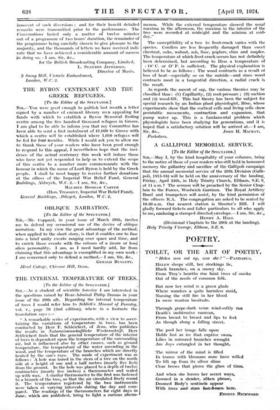THE INTERNAL TEMPERATURE OF TREES.
[To the Editor of the SPECTATOR.] Sin,—As a student of scientific forestry I am interested in the questions raised by Rear-Admiral Philip Dumas in your issue of the 29th tilt. Regarding the internal temperature of trees I would refer him to Schlich's Manual of Forestry, vol. v., page 76 (2nd edition), where in a footnote the translation says :— " A remarkable series of experiments, with a view to ascer- taining the variations of temperature in trees, has been -conducted by Ilerr F. Schleichert, of Jena, who publishes the results in Naturwissenschaftliche Wochenschr(ft. Herr Schleichert finds that the general temperature of the interior of trees is dependent upon the temperature of the surrounding air, but is influenced also by other causes, such as ground temperature, the temperature of the water ascending in the 'wood, and the temperature of the branches which are directly heated by the sun's rays. The mode of experiment was as follows : A hole was bored in the stem of a tree on the north . side at a height of one and a half metres (nearly five feet) from the ground. In the hole was placed to a depth of twelve centimetres (nearly five inches) a thermometer and sealed up with wax. A similar thermometer to the first was fastened to a branch of the tree, so that the air circulated freely round it. The temperatures registered by the two instruments were taken at varying intervals during the- day and com- pared. The readings of the thermometers for eight days in June. which are published, bring to light a curious pheno-
menon. While the external temperature showed the usual maxima in the afternoon, the maxima in the interior of the tree were recorded at - midnight and the minima at mid:- day."
The susceptibility of a tree to frost-crack varies with the species. Conifers are less frequently damaged than sweet chestnut, oaks, walnut, ash, lime, poplars, elms and maples. The temperature at which frost-crack occurs has not definitely been determined, but according to Hess a temperature of - 18° C. or 0° F. is sufficient. The physical explanation is believed to be as follows : The wood contracts as a result of loss of heat—especially so on the outside—and since •wood contracts most in a tangential direction, a radial crack is the result.
As regards the ascent of sap, the various theories may be classified thus : (1) Capillarity, (2) root-pressure ; (3) suction and (4) wood-lift. This last theory has been the subject for special research by an Indian plant physiologist, Bfise, whose experiments show that the cortical cells and living cells show peristaltic movements, contraction and expansion, that pump water up. This is a fundamental problem which physiologists have been studying for generations, and it is hoped that a satisfactory solution will he arrived at. —I am,


































 Previous page
Previous page